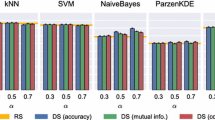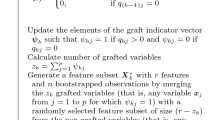Abstract
The discriminating capabilities of a random subspace classifier are considered. As a result of analysis of the probability density distribution of threshold values, an estimate is obtained for the minimum distinguishable distance. Real examples of separating surfaces for classical two-imensional problems are given. An algorithm is proposed for local averaging of a synapse matrix to improve the classifier performance in solving problems with overlapping probability distributions. The random subspace classifier is proved to be universal.
Similar content being viewed by others
References
D. V. Zhora, “Analysis of a classifier with random thresholds,” Cybernetics and Systems Analysis, No. 3, 72–91 (2003).
E. M. Kussul, T. N. Baidyk, V. V. Lukovich, and D. A. Rachkovskij, “Adaptive high performance classifier based on random threshold neurons,” in: R. Trappl (ed.), Cybernetics and Systems’94, World Sci. Publ. Co. Pte. Ltd., Singapore (1994), pp. 1687–1695.
E. M. Kussul, D. A. Rachkovskij, and D. C. Wunsch, “The random subspace coarse coding scheme for real-valued vectors,” in: Proc. Int. Joint Conf. Neural Networks, 1, Honolulu (1999), pp. 450–455.
S. Haykin, Neural Networks: A Comprehensive Foundation, Prentice Hall, Upper Saddle River (N.J.) (1999).
G. A. Korn and T. M. Korn, Mathematical Handbook for Scientists and Engineers [Russian translation], Nauka, Moscow (1970).
C. Aviles-Cruz, A. Guérin-Dugué, J. L. Voz, et al., “Databases, enhanced learning for evolutive neural architecture,” Tech. Rep. R3-B1-P, INPG, UCL, TSA, (1995), www.dice.ucl.ac.be/neural-nets/Research/Projects/ELENA/elena.htm.
F. Blayo, Y. Cheneval, A. Guérin-Dugué, et al., “Benchmarks, enhanced learning for evolutive neural architecture,” Tech. Rep. R3-B4-P, INPG, EERIE, EPFL, UPC, UCL (1995).
G. V. Cybenko, “Approximation by superpositions of a sigmoidal function,” Mathematics of Control, Signals, and Systems, 2, 303–314 (1989).
D. V. Zhora, “Evaluating performance of random subspace classifier on ELENA classification database,” in: Proc. Int. Conf. Artificial Neural Networks 2005, LNCS, 3697 (2005), pp. 343–349.
V. V. Lukovich and D. A. Rachkovskii, “Investigation of characteristics of a random threshold neural classifier,” in: Neural-Net Technologies and Neurocomputers, V. M. Glushkov Cybernetics Institute of AS of Ukraine, Kiev (1994), pp. 27–36.
V. V. Lukovich, “Transformation of data at the input of a random threshold neural classifier,” in: Neural-Net Systems of Information Processing, V. M. Glushkov Cybernetics Institute of AS of Ukraine, Kiev (1996), pp. 12–19.
D. A. Rachkovskii, S. V. Slipchenko, E. M. Kussul, and T. N. Baidyk, “Properties of numeric codes for the scheme of random subspaces RSC,” Cybernetics and Systems Analysis, No. 4, 39–52 (2005).
D. A. Rachkovskii, S. V. Slipchenko, A. A. Frolov, and D. Husek, “Resolution of binary coding of real-valued vectors by hyperrectangular receiptive fields,” Cybernetics and Systems Analysis, No. 5, 3–16 (2005).
S. V. Slipchenko, I. S. Misuno, and D. A. Rachkovsky, “Properties of coding numerical quantities by random hyperrectangular receptive fields,” Mat. Mashiny i Sistemy, No. 4, 15–29 (2005).
R. O. Duda, P. E. Hart, and D. G. Stork, Pattern Classification, Wiley, New York (2000).
Author information
Authors and Affiliations
Additional information
__________
Translated from Kibernetika i Sistemnyi Analiz, No. 6, pp. 55–70, November–December 2006.
Rights and permissions
About this article
Cite this article
Zhora, D.V. Analysis of separating surfaces formed by a random subspace classifier. Cybern Syst Anal 42, 817–830 (2006). https://doi.org/10.1007/s10559-006-0122-3
Received:
Issue Date:
DOI: https://doi.org/10.1007/s10559-006-0122-3




